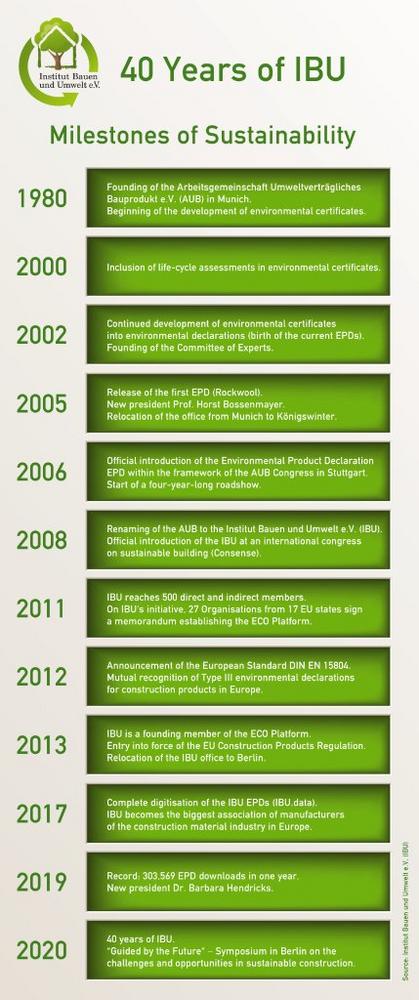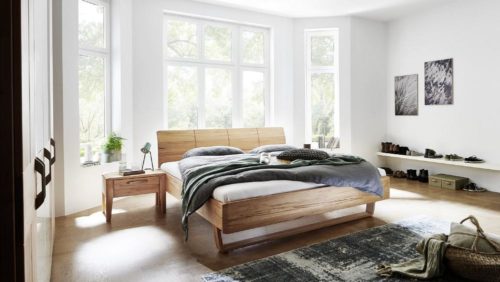
Building on Transparency – Institut Bauen und Umwelt Turns 40
(tdx) Building and the environment are inseparable, the idea of sustainable building has become a buzzword. However, buildings are material- and energy-intensive and thus represent major human interference in nature and the environment. In the 1970s, as resource scarcity was first being discussed in society, energy-saving regulations quickly gave rise to concrete specifications. It was during this time that a string of initiatives were founded with the goal of analysing and evaluating the complex patterns between environmental and economic resource use and their socio-cultural qualities.
The "Blue Angel" ecolabel, introduced in 1978 by the German Ministry of the Environment and the ministers of the federal states responsible for environmental protection, was the first of its kind and has since been awarded for particularly environmentally friendly products and services together with the non-profit RAL GmbH. However, environmental properties not mentioned in the award criteria are not considered.
But for most construction products, this kind of label is not very helpful. Different use scenarios and in particular the use as an intermediate or semi-manufactured product make it difficult to apply such an approach. Moreover, focusing on a single rating criterion with regard to the various performance criteria of components is usually not appropriate. So, as early as 1980, around a dozen construction material manufacturers founded the Arbeitsgemeinschaft Umweltverträgliches Bauprodukt (AUB). The goal of this initiative was to collaboratively publish environmental information according to the same standards, including information on processing, service life, landfilling and recycling. These manufacturer declarations were released as an environmental sustainability data sheet and contained, in particular, the performance data of the products. Sector groups, which allowed for external supervision, were formed as control mechanisms, and an evaluation committee was established. Manufacturers of mineral construction products were the main users. The outlined advantages were contrasted by the prejudiced perception of manufacturers‘ declarations and some stakeholders missing a striking evaluation.
The problem of appropriate information suitable to wide-ranging environmental issues was scientifically developed and standardised in the late 1990s. With the development of the so-called life cycle assessment and its international standardisation, a mechanism was created with which, for the first time, essential environmentally relevant information could be scientifically recorded, calculated and compared. In addition, the ecolabels were structured in three standardised groups: Type I as environmental labels with clearly defined and limited criteria, Type as self-declared environmental claims, and Type III as a neutral and transparent environmental declaration. The members of the AUB took advantage of this opportunity. With the support of the Federal Environment Agency and scientists such as Dr. Eva Schmincke and Prof. Dr.-Ing. Thomas Lützkendorf, the scientific findings were specified and made practicable for the construction industry. At the same time as these developments were taking place, the EU harmonised its construction product laws. In the Construction Products Directive, so-called basic requirements were formulated, which, among other things, included information on hygiene, health and the environment as well as on the sustainable use of natural resources. The members of the AUB used this general framework to further develop the Environmental Product Declarations (EPDs) into their current format, which have not only become the German but also the international standard.
However, due to the extensive and detailed discussions and analyses to differentiate and summarise the different product categories, it would take until 2005 before the first EPD was officially awarded to Rockwool. This situation was used by those responsible at the AUB to also develop a new structure and external presentation. The AUB became the Institut Bauen und Umwelt (IBU) with a neutral and honorary president. The long-standing president of the Deutsches Institut für Bautechnik (German Institute for Construction Technology, DIBt) Prof. Dr.-Ing. Horst Bossenmayer took over this office.
The breakthrough of this information format was achieved with the amendment of the Construction Products Directive to the Construction Products Regulation in 2011. The European Commission was assured by members of the IBU that EPDs are the appropriate tool to convey environmental information. The reference to EPDs in the recitals of the Construction Products Regulation for basic requirements 3 (hygiene, health and environment) and 7 (sustainable use of natural resources) was included. This reference to a suitable set of mechanisms for environmentally relevant information in addition to the mandatory CE marking on performance characteristics was consistently used by the IBU office. From 2006 to 2010, the new format was presented nationwide in a kind of roadshow. "The success was and is extraordinary" says Dipl.-Ing. Hans Peters, Chairman of the Board of IBU. "A handful of pioneers have developed the standard solution that the entire building products manufacturers‘ industry uses, either individually or via associations. Today, more than 210 companies and associations are members of the IBU, representing more than 1,800 EPDs, which in turn contain even more products" The IBU’s international success is also remarkable – almost a third of its members are foreign manufacturers. This is also due to the fact that those responsible recognised early on the international harmonisation of procedural issues, boundary and general regulations. As the initiator of a European EPD platform, the IBU has ensured that manufacturers do not have to work out core environmental information anew in every country.
The IBU is currently developing the next level of sustainability related information. It is necessary both to extend the product information and to digitalise all data in order to ultimately make the life cycle assessment and environmental data BIM compatible. "With our ibu.data and SuPIM service we are heading towards making our sustainability data available for many new solutions”, explains Managing Director Dr. Alexander Röder. The former Federal Minister for the Environment and Construction, Dr. Barbara Hendricks, who stands for independent, transparent and credible information, has been chosen as president for the new challenges. With the EPDs and the other information tools of the IBU, the construction industry is taking a pioneering role in all industrial sectors in Germany with regard to environmental and sustainability information.
Founded in 1980 under the name Arbeitsgemeinschaft Umweltverträgliches Bauprodukt e.V. (Working Group environment-friendly construction product, AUB) and subsequently renamed the Institut Bauen und Umwelt e.V. (Institute Construction and Environment, IBU), the IBU today has over 220 members from various sectors in the construction industry that are committed to sustainable construction.
The IBU operates the leading international programme for environmental product declarations (EPDs) for the construction industry and is the leading organisation in Europe for building product declarations that conform to the European standard EN 15804.
Its aim is to provide a cross-sector, independent information system for construction products and building components that sheds transparency on their environmental impact as well as provides independent information about the entire life cycle to all parties involved in construction.
This independent source of information for construction products and building components ensures that the ecological factors can be taken into account in the sustainability assessment of buildings. With almost 40 years of commitment, the IBU has developed an industry standard that is now widely used in all areas of the construction industry. Over the years, this has given building product manufacturers a pioneering edge.
Institut Bauen und Umwelt e.V.
Hegelplatz 1
10117 Berlin
Telefon: +49 (30) 3087748-0
Telefax: +49 (30) 3087748-29
http://ibu-epd.com
Unternehmenskommunikation
Telefon: +49 (821) 2589300
E-Mail: ibu@prcompany.de
![]()





